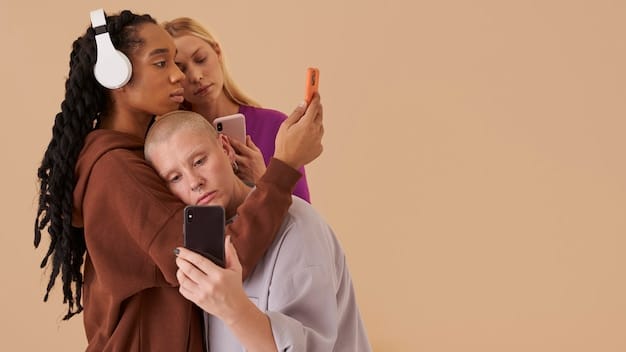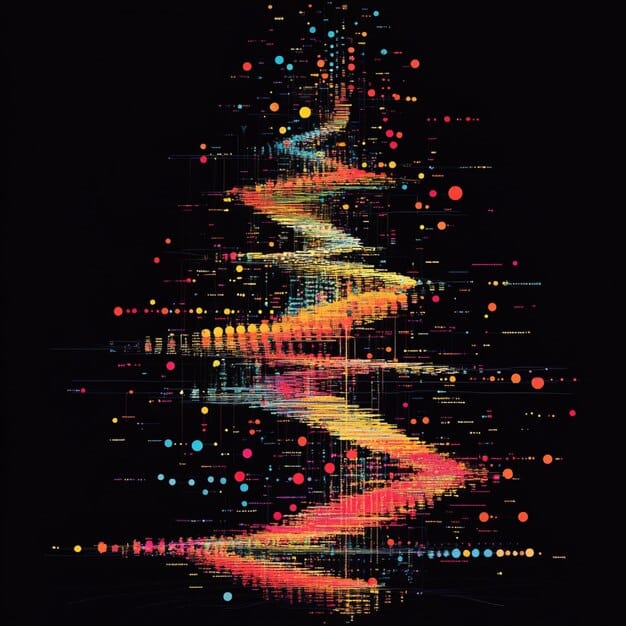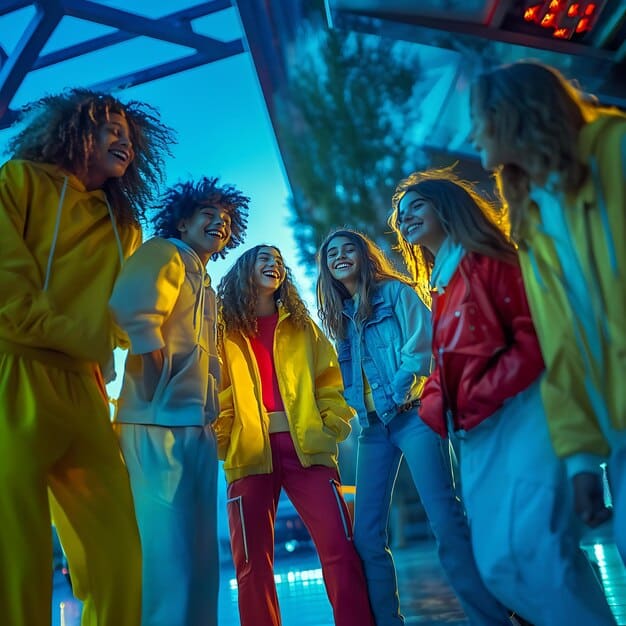Gen Z’s Impact on US Music: TikTok & 2025 Chart Dominance

Gen Z’s pervasive influence, amplified by platforms like TikTok, is fundamentally reshaping the US music industry’s charting dynamics by 2025, prioritizing authenticity and digital engagement over traditional metrics to discover new hits and artists.
The landscape of the music industry is in constant flux, but few forces have provoked such a dramatic shift as Generation Z. By 2025, Gen Z’s Impact on the US Music Industry: How TikTok is Shaping the Charts in 2025 will be undeniable, as this digital-native demographic continues to redefine how music is discovered, consumed, and ultimately, how hits are made. Their intimate relationship with technology, particularly platforms like TikTok, has fragmented traditional pathways to stardom, creating a new ecosystem where virality often trumps traditional label backing.
The TikTok Ecosystem: A New A&R Department
The rise of TikTok has fundamentally altered the scouting and development process for new artists, effectively becoming a global, decentralized A&R (Artists and Repertoire) department. This social media giant offers an unparalleled platform for emerging talent to gain traction, sometimes overnight, without the traditional gatekeepers of the industry. It’s a direct-to-fan pipeline where authenticity and creativity reign supreme.
From Niche to Mainstream: The Power of Short-Form Video
TikTok’s short-form video format encourages rapid content creation and consumption, leading to quick trends and explosions of popularity. A song might go viral from a dance challenge, a humorous skit, or a poignant background track, catapulting relatively unknown artists into the mainstream consciousness. This organic discovery mechanism means that a track’s success isn’t solely dependent on radio play or MTV rotations anymore; it’s about connecting with a global audience instantaneously.
- Authenticity often trumps high production value.
- Dance challenges and memes drive virality.
- Loops and snippets create immediate recall.
The Democratization of Discovery
TikTok has leveled the playing field, making it possible for artists from all backgrounds to break through. It bypasses the traditional filters of record labels and radio stations, giving a voice to those who might otherwise be overlooked. This democratization of discovery empowers creators and gives listeners a direct say in what becomes popular. The platform’s algorithm, designed to serve users content they’ll engage with, quickly identifies emerging trends and amplifies them, creating a self-sustaining cycle of musical exploration.
This dynamic environment forces major labels to constantly monitor TikTok feeds, often signing artists or licensing songs that have already demonstrated significant fan engagement. The risk profile decreases for labels when a track has a proven viral footprint, shifting the traditional industry model from “predictive” to “reactive.”
Gen Z’s Consumption Habits: Beyond Traditional Metrics
Gen Z’s approach to music consumption is a multi-faceted digital tapestry, far removed from the linear album listening of previous generations. They are not passive listeners; they are active participants, curators, and creators within their digital ecosystems. This fundamental shift necessitates a re-evaluation of what constitutes a “hit” and how success is measured.
For Gen Z, music is deeply intertwined with self-expression and identity. They use platforms like Spotify, Apple Music, and YouTube not just for listening, but for crafting personalized playlists, sharing experiences, and discovering niche genres. This fluid approach means that loyalty to a single artist or genre is less common; instead, they are driven by mood, context, and constant novelty. The concept of an “album cycle” as the sole measure of an artist’s longevity is diminishing, making way for a continuous stream of releases and interactions.
The Rise of Playlist Culture and Micro-Genres
Playlists, whether curated by streaming services, influencers, or peers, are the new albums. Gen Z meticulously crafts and shares playlists for every mood and activity, leading to the fragmentation of music consumption into highly specific micro-genres. This deep dive into niche sounds means that artists don’t necessarily need broad appeal to find a dedicated audience; they need to resonate deeply with a specific community.
- Curated playlists are the new radio.
- Micro-genres enable deeper niche exploration.
- Personalization drives listening habits.
Snackable Content and Visual Storytelling
Beyond audio, Gen Z consumes music visually. TikTok, Instagram Reels, and YouTube Shorts are integral to their musical experience, offering visual narratives that enhance and often drive the popularity of a song. A compelling visual snippet can make a song unforgettable, demonstrating that for this generation, the auditory and visual experiences of music are intrinsically linked. Artists must now consider the “TikTokability” of their music, ensuring it translates well into short, engaging video formats that encourage user-generated content.
The Shifting Power Dynamics: Artists, Labels, and Fans
The interplay between artists, record labels, and fans has undergone a seismic shift, largely catalyzed by Gen Z’s digital fluency. The traditional hierarchy, where labels held almost absolute power, is dissolving, replaced by a more collaborative and fan-centric model. Artists now possess unprecedented tools for direct engagement, while fans wield collective influence, impacting everything from song promotion to artist careers. This evolving dynamic demands adaptability from all stakeholders, redefining success beyond mere sales figures.
Direct-to-Fan Engagement and Community Building
Gen Z artists are adept at bypassing traditional intermediaries, building direct relationships with their fanbase through social media. This direct engagement fosters a strong sense of community, transforming listeners into active participants and advocates. From Discord servers to Instagram Live Q&As, artists are leveraging these platforms to cultivate a loyal following, gather instant feedback, and even co-create content. This direct line of communication builds authenticity and trust, values highly prized by younger audiences.
Labels as Partners, Not Dictators
Record labels, once monolithic gatekeepers, are increasingly operating as partners rather than dictators. They now seek artists who have already established a digital presence and a demonstrable fanbase, often leveraging these existing communities rather than building them from scratch. Labels provide resources—funding, marketing, distribution, and legal expertise—but artists retain more creative control and a larger share of their intellectual property. This mutually beneficial relationship acknowledges the artist’s inherent power in the digital age.
Fan-Driven Virality and Metrics
The influence of fans on a song’s trajectory has never been more pronounced. A song’s viral success on TikTok or other platforms isn’t just a happy accident; it’s often the result of collective fan effort, whether through dance challenges, sound usage, or consistent sharing. This fan-driven virality provides labels with invaluable data points, offering real-time insights into what resonates with audiences and guiding marketing strategies. The metrics of engagement—shares, saves, duets—are as, if not more, important than raw stream counts.
Algorithms and Analytics: The New Chart Compilers
In the modern music ecosystem, algorithms and data analytics have become the silent architects of the charts, far surpassing the influence of traditional radio programming or music television. These sophisticated systems curate listening experiences, identify emerging trends, and ultimately determine what music gains traction. Understanding how these algorithms operate is crucial for artists and labels aiming to navigate the increasingly complex pathways to commercial success within the Gen Z’s Impact on the US Music Industry: How TikTok is Shaping the Charts in 2025 landscape.

Streaming services like Spotify and Apple Music use complex algorithms to recommend music based on user listening habits, influencing discovery and consumption. These algorithms prioritize engagement, analyzing factors like skips, saves, and repeat listens to determine a song’s popularity and potential for wider reach. This data-driven approach means that a song’s success often correlates with its algorithmic “stickiness” rather than being solely reliant on human curation.
TikTok’s “For You Page” as the Ultimate Gatekeeper
TikTok’s “For You Page” (FYP) algorithm is arguably the most powerful chart-shaping tool of our time. It intelligently pushes content to users based on their interactions, likes, shares, and watch time. A song’s inclusion and repeated appearance on the FYP can translate into millions of views and massive exposure, often bypassing traditional marketing efforts entirely. Businesses in the music realm are now analyzing FYP patterns to identify potential trends, sometimes weeks or months before they hit mainstream charts.
Data-Driven A&R and Marketing Decisions
Labels are increasingly relying on data analytics to inform their A&R strategies and marketing campaigns. They analyze streaming data, social media engagement, and viral trends to identify promising artists and songs. This data-driven approach minimizes risk and maximizes impact, allowing labels to invest in content that has already demonstrated audience resonance. Marketing efforts are also tailored, targeting specific demographics and platforms where the data indicates the highest potential for engagement.
Beyond the Screen: Gen Z’s Influence on Live Music and Merch
While Gen Z’s digital presence is undeniable, their influence extends far beyond screens, deeply impacting the live music experience and the burgeoning merchandise market. They are not content with passive consumption; they crave authentic experiences and tangible connections that reflect their values and identities. This demand for meaningful engagement is reshaping how artists tour, interact with fans, and monetize their creative output.
Live music events, from intimate club shows to massive festivals, are no longer just about the performance; they are immersive, shareable experiences. Gen Z attendance at concerts is fueled by a desire for community, a wish to create viral content, and a quest for unique memories. Artists are adapting by creating more visually stimulating and interactive shows, understanding that a concert is as much about the Instagram story as it is about the sound quality.

The Experiential Economy and Visual Storytelling
For Gen Z, concerts are prime opportunities for self-expression and content creation. The aesthetics of a live show, from stage design to lighting, are paramount, as these elements contribute to the highly shareable visual content that proliferates across social media. Artists and promoters are increasingly designing experiences specifically for “Instagrammability” and “TikTokability,” recognizing that viral moments from live events drive further engagement and ticket sales.
Merchandise as Identity and Collectibles
Merchandise has evolved beyond simple band tees; for Gen Z, it’s a form of expressing identity, belonging, and supporting their favorite artists. They seek unique, limited-edition items that are both stylish and environmentally conscious. This generation values authenticity, sustainability, and artistic collaborations. Artists are responding by offering diverse product lines, from streetwear and accessories to vinyl records and digital collectibles, turning merch into a significant revenue stream and a powerful bond with their fanbase. The storytelling behind the merch, often tied to tour themes or album concepts, also plays a crucial role in its appeal.
Preparing for 2025: Strategies for Success
As 2025 approaches, the music industry must continue to adapt to Gen Z’s evolving influence, recognizing that what worked yesterday may not be effective tomorrow. Success will hinge on a dynamic blend of digital fluency, authentic engagement, and a willingness to embrace new metrics and revenue streams. Artists, labels, and platforms alike must be agile, forward-thinking, and deeply attuned to the pulse of youth culture.
Embracing Authenticity and Niche Marketing
For artists, cultivating authenticity is paramount. Gen Z values genuine connection and transparency, gravitating towards creators who share their unfiltered selves. This translates into content that feels less polished and more relatable. Marketing strategies should focus on niche communities and specialized platforms rather than broad, mass-market campaigns. Identifying and engaging with the micro-audiences where a song resonates most deeply will be more effective than trying to appeal to everyone.
Leveraging AI and Data for Predictive Insights
The intelligent use of AI and data analytics will become even more critical. Labels and artists can leverage these technologies to predict trends, identify emerging talent, and optimize content distribution. AI-powered tools can analyze vast amounts of data—from social media sentiment to streaming patterns—to uncover hidden gems and forecast a song’s potential trajectory. This predictive capability allows for more strategic investments and targeted marketing efforts.
Diversifying Revenue Streams and Fan Engagement
Artists can no longer rely solely on streaming royalties. Diversifying revenue streams through merchandise, NFTs, live stream events, brand partnerships, and direct fan subscriptions will be essential for long-term sustainability. Engaging fans beyond just music consumption, empowering them to participate in the creative process, and offering exclusive experiences will deepen loyalty and unlock new commercial opportunities. The future of the music industry in 2025 will reward those who embrace innovation and prioritize the unique preferences of the Gen Z audience.
| Key Influence | Brief Description |
|---|---|
| 📲 TikTok’s A&R Power | TikTok drives viral discovery, acting as a primary artist scout and trendsetter for chart hits. |
| 🎧 Gen Z Consumption Habits | Prioritize playlists, micro-genres, and visual content over traditional album listening. |
| 🤝 Shifting Power Dynamics | Artists gain direct fan engagement; labels become partners, relying on fan-driven data. |
| 📈 Algorithmic Dominance | Algorithms and data analytics dictate chart success and music recommendations. |
Frequently Asked Questions About Gen Z’s Music Impact
TikTok offers an unprecedented direct path to stardom, allowing new artists to gain massive exposure overnight through viral sounds or challenges. It acts as an organic A&R platform, where a song’s virality can lead to record deals, bypassing traditional industry gatekeepers. This enables artists to build a loyal fanbase independently before label involvement.
Beyond TikTok, Gen Z heavily relies on streaming services like Spotify and Apple Music for personalized listening and playlist creation. YouTube remains crucial for music videos and discovery. They also use visual platforms like Instagram Reels and Snapchat for sharing short-form video content linked to music, often integrating songs into their daily digital lives.
Algorithms analyze various engagement metrics: listens, shares, saves, skips, and user-generated content. On TikTok, the “For You Page” determines virality. For streaming services, deep engagement metrics indicate popularity and recommend songs to wider audiences, significantly influencing their ascent on official charts by showcasing sustained listener interest.
Record labels are increasingly acting as partners rather than sole gatekeepers. They primarily leverage existing digital virality and fanbases to sign artists, providing resources for marketing, distribution, and legal support. Labels now gather and analyze data from platforms like TikTok to inform their A&R decisions, adapting to the shifts in audience discovery.
Gen Z views live music as immersive, shareable experiences, prioritizing visual appeal for social media content. They drive demand for unique, authentic merchandise that reflects their identity and supports artists directly, turning merch into valuable collectibles. This pushes artists to innovate in stage design and diversify product offerings, blurring lines between performance and personal expression.
Conclusion
The transformative influence of Gen Z on the US music industry is not merely a trend; it’s a fundamental reshaping of its very core. Driven by digital fluency, a demand for authenticity, and a preference for personalized, shareable content, this generation has elevated platforms like TikTok from mere social apps to powerful arbiters of musical success. As we move further into 2025, the industry’s ability to thrive will increasingly depend on its capacity to understand, adapt to, and innovate within this dynamic landscape, where virality, community, and direct artist-to-fan connections reign supreme. The future of hits is being written, one viral snippet at a time, by Gen Z.





